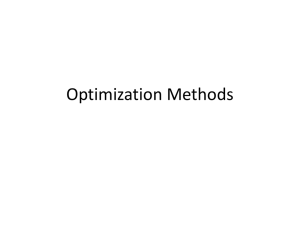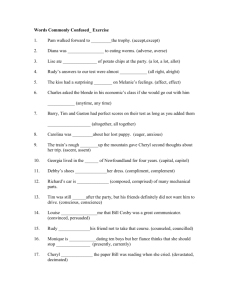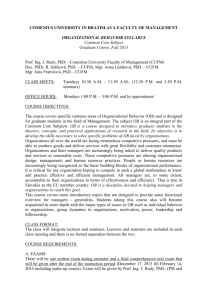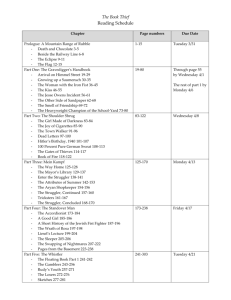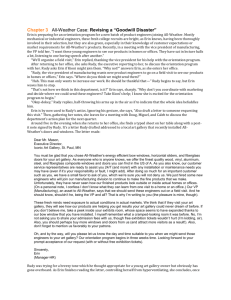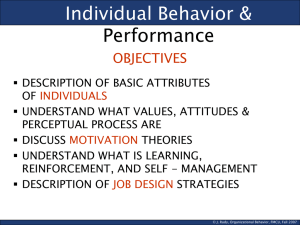Greenfield P.S. BSEA #12-1305 - Massachusetts Department of
advertisement
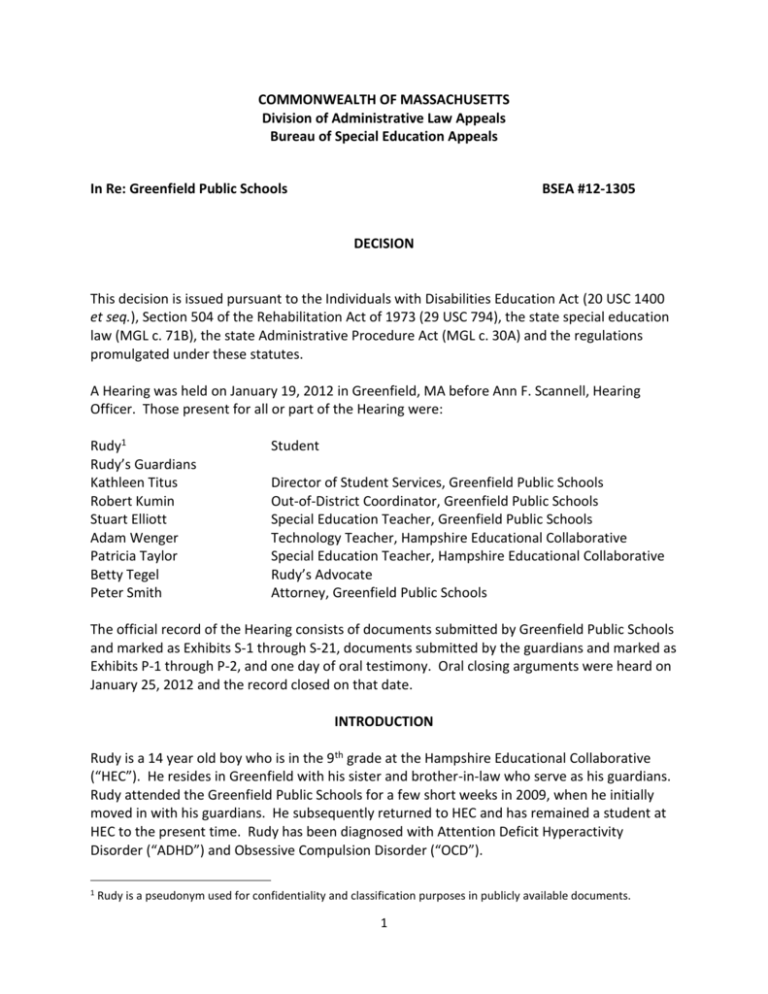
COMMONWEALTH OF MASSACHUSETTS Division of Administrative Law Appeals Bureau of Special Education Appeals In Re: Greenfield Public Schools BSEA #12-1305 DECISION This decision is issued pursuant to the Individuals with Disabilities Education Act (20 USC 1400 et seq.), Section 504 of the Rehabilitation Act of 1973 (29 USC 794), the state special education law (MGL c. 71B), the state Administrative Procedure Act (MGL c. 30A) and the regulations promulgated under these statutes. A Hearing was held on January 19, 2012 in Greenfield, MA before Ann F. Scannell, Hearing Officer. Those present for all or part of the Hearing were: Rudy1 Rudy’s Guardians Kathleen Titus Robert Kumin Stuart Elliott Adam Wenger Patricia Taylor Betty Tegel Peter Smith Student Director of Student Services, Greenfield Public Schools Out-of-District Coordinator, Greenfield Public Schools Special Education Teacher, Greenfield Public Schools Technology Teacher, Hampshire Educational Collaborative Special Education Teacher, Hampshire Educational Collaborative Rudy’s Advocate Attorney, Greenfield Public Schools The official record of the Hearing consists of documents submitted by Greenfield Public Schools and marked as Exhibits S-1 through S-21, documents submitted by the guardians and marked as Exhibits P-1 through P-2, and one day of oral testimony. Oral closing arguments were heard on January 25, 2012 and the record closed on that date. INTRODUCTION Rudy is a 14 year old boy who is in the 9th grade at the Hampshire Educational Collaborative (“HEC”). He resides in Greenfield with his sister and brother-in-law who serve as his guardians. Rudy attended the Greenfield Public Schools for a few short weeks in 2009, when he initially moved in with his guardians. He subsequently returned to HEC and has remained a student at HEC to the present time. Rudy has been diagnosed with Attention Deficit Hyperactivity Disorder (“ADHD”) and Obsessive Compulsion Disorder (“OCD”). 1 Rudy is a pseudonym used for confidentiality and classification purposes in publicly available documents. 1 On August 12, 2011, Greenfield Public Schools (“Greenfield”) filed a request for Hearing with the Bureau of Special Education Appeals (“BSEA”). It is Greenfield’s position that the May 2, 2011 to May 1, 2012 Individualized Education Program (“IEP”) provides Rudy with a free, appropriate public education in the least restrictive environment (“FAPE”).2 On August 25, 2011, Greenfield filed a request to postpone the Hearing which was originally scheduled for September 1, 2011. The guardians also filed a request to postpone the Hearing and requested that the parties attempt to resolve the issues through mediation. The BSEA issued an order rescheduling the Hearing to September 12, 2011. A conference call was held with the parties on September 8, 2011. Greenfield expressed their desire to not participate in mediation. The guardians requested that the Hearing be postponed so they could obtain legal representation. The Hearing was postponed until October 4, 2011. At the Hearing on October 4, 2011, Advocate Betty Tegel appeared on the guardian’s behalf requesting that the matter be postponed. After contacting the guardians via telephone conference and over the objection of Greenfield, the matter was postponed until November 2, 2011. The matter did not go forward on November 2, 2011 due to weather. The matter was rescheduled to January 19, 2012 and moved forward on that date. ISSUES The issues to be decided in this matter are; 1. Whether the May 2, 2011 to May 1, 2012 IEP is reasonably calculated to provide Rudy with a free, appropriate public education in the least restrictive environment; 2. If not, can the IEP be modified to meet this standard; 3. If not, is the HEC program an appropriate program. FACTS Rudy is a 14 year old boy who lives with his guardians in Greenfield. He previously lived in Palmer with his mother. Rudy started attending HEC in April of 2008 pursuant to a Palmer IEP. When his mother suddenly passed away in December of 2009, he moved to Greenfield to live with his older sister and her husband. They subsequently were appointed Rudy’s guardians. Due to some confusion, Rudy was removed from HEC and attended Greenfield Middle School for a few weeks before he returned to the middle school program at HEC. Rudy is currently in the 9th grade at HEC. (Exhibit S-1 and testimony of Titus, Kumin, Taylor and Guardians) 2 The guardians did not file a written response to the Hearing request but did express their opposition to placing Rudy at the Transitions Program at Greenfield High School. 2 Rudy has been diagnosed with ADHD and OCD. He is on medication to address these issues. Rudy also presents with dysgraphia, executive functioning difficulties and memory deficits. Rudy enjoys science, working with computers, playing video games and interacting with adults. He particularly enjoys hands on science and technology projects. Rudy would like to take as many classes as possible in science, computer technology, programming, graphic design and electronics. He is planning on a career involving computers after he graduates. (Exhibits S-1, 2 and 21 and testimony of Guardians, Wenger and Taylor) Rudy began attending the middle school program at HEC in April 2008. He is currently attending HEC’s high school program. His progress reports from June of 2008 showed that he had increased his ability to self-monitor for on-task behaviors and had developed confidence and practical strategies to attempt academic tasks he perceived as difficult and to reach social compromise with staff and peers. Rudy was also able to develop working relationships with staff to help prevent shutdowns and behavioral consequences. Rudy’s progress reports one year later in June of 2009, reflected continued improvement in meeting the behavioral and academic expectations of his program. (Exhibits S-12 and S-13 and testimony of Taylor) In March of 2010, Rudy underwent a psychoeducational assessment through HEC. The assessment was conducted by HEC’s school psychologist, Eva Gibavic. Ms. Gibavic tested Rudy’s cognitive functioning, memory, learning and attention skills, academic abilities and visual-perceptual and fine motor skills. Rudy exhibited average vocabulary and verbal reasoning abilities and high average to superior perceptual reasoning skills. His visual memory was relatively weak with grapho-motor deficits impacting his visual memory. Rudy’s verbal memory scores were affected by his attentional difficulties and ranged from significantly below average to average. His scores in reading fell in the average range. (Exhibit S-4) Ms. Gibavic opined that Rudy would benefit from developing his executive skills with the use of templates. She also recommended that Rudy continue in a highly structured academic program with a low student/staff ratio, receive specialized instruction in reading, writing and math and have access to assistive technology, templates for the writing process and computerized programs in game format to improve automaticity of basic math facts. Ms. Gibavic stated that implementing these recommendations and accommodations would help to address Rudy’s deficits in written output, attention and executive functioning. (Exhibit S-4) An annual TEAM meeting was held on May 20, 2010 to discuss the assessments3 and to write a new IEP. The TEAM agreed to continue Rudy’s placement at HEC through the summer. There was discussion about placement at Greenfield Public School’s Poet Seat for the 2010 to 2011 school year. A decision on placement, however, was deferred until the TEAM met again in late July. (Exhibits S-17 and S-1 and testimony of Kumin and Guardians) 3 An occupational therapy assessment was conducted in February 2010. No occupational therapy services were recommended at that time. 3 A new IEP was proposed from May 20, 2010 to May 19, 2011. This IEP provided for summer services at HEC. The proposed IEP contained goals in math, reading, written language and functional academics, as well as social/emotional goals. Accomodations included therapy, a positive rewards behavior program, frequent breaks and the use of templates, graphic organizers, word processor, homework planner and editing checklists. Rudy was to receive all educational services by a special education teacher and also counseling once a week with the school counselor. (Exhibit S-1 and testimony of Kumin) Rudy’s progress reports from June of 2010 indicate that he was implementing new strategies with social compromise, class work and communication with peers and adults. Overall he continued to show growth in his emotional and social goals. Rudy was improving with independent use of templates and organizers, completion of class and homework assignments and daily organization skills. The notes also reflected progress with his math and writing skills. (Exhibit S-11) Rudy attended the summer 2010 program at HEC. He continued to make progress socially, emotionally and academically. His guardians expressed to Greenfield their desire and Rudy’s desire that he remain at HEC for the 2010 to 2011 school year. The Guardians did not like the Poet Seat Program at Greenfield. After internal discussion and review of information, Greenfield agreed to let Rudy continue at HEC for the 2010 to 2011 school year. Rudy’s progress reports from November 2010 document further progress socially, emotionally and academically. (Exhibits S-9 and S-10 and testimony of Kumin and Guardians) Rudy’s April 2011 progress reports were similarly positive. Rudy was better able to express himself but still needed assistance when stressed or overwhelmed. He continued to shut down or become disruptive when he perceived something “unfair”. Rudy also refused to bring homework home and study for tests and quizzes resulting in lower grades. His teachers, however, noticed an overall improvement in his confidence, his academic abilities and his executive functioning skills. (Exhibit S-8) An annual TEAM meeting was held on May 2, 2011. HEC personnel reported that Rudy had made significant social and emotional progress and improvement in expressive language when he felt safe and familiar with the adults around him. Rudy’s progress on his functional academic goals was slow. He did show improvement in his reading fluency on 6th grade texts. Rudy’s guardian reported that Rudy wanted to graduate from high school and attend college. (Exhibit S-18) A new IEP was proposed with effective dates of May 2, 2011 to May 1, 2012. The IEP reflected that the coming school year would be a transition for Rudy from middle school to high school. The proposed placement for Rudy was the Transitions Program at Greenfield High School. The services in the proposed IEP essentially mirrored the services in the prior IEP. The proposed IEP contained social/emotional, functional academics, reading, written language and math goals and similar accommodations. The services would be provided in a substantially separate 4 classroom (the Transitions Program) and Rudy would also receive sixty minutes of therapy per week from a psychologist. (Exhibit S-2 and testimony of Kumin and Elliott) The Transitions Program is housed at Greenfield High School. It is a highly structured, small (1012 students), therapeutic classroom. The profiles of the students in the Transitions Program are similar to Rudy’s profile. The students exhibit anxiety, ADHD, social/emotional deficits and learning disabilities in math and written expression. The students are taught by a certified special education teacher, certified teachers in math and English and a reading specialist. In addition, a psychologist provides individual therapy, group therapy and social pragmatics. The program is also staffed by two full time and one part time paraprofessionals. The students utilize assistive technology including computers, smart boards and Kurzweil. In addition, the Transitions Program offers students the opportunity to access regular education classes, the myriad of extra-curricular clubs and activities, access to post-secondary education through online classes and classes at Greenfield Community College as well as internships in the technology field. (Exhibits S-2, and S-15 and testimony of Kumin and Elliott) Rudy’s guardians expressed their preference and Rudy’s preference that Rudy remain at HEC, and on July 11, 2011, Rudy’s guardians rejected the IEP and proposed placement. They rejected the IEP because of the proposed placement at Greenfield High School and maintained their request (and Rudy’s) that he be allowed to remain at HEC. (Exhibit S-2 and testimony of Kumin and Guardians) A visit to the Transitions Program was scheduled for June 13, 2011. Neither Rudy nor his guardians appeared for the visit. In September of 2011, the Transitions Program teacher, Stuart Elliott, and Greenfield’s special education director, Ms. Kathleen Titus, visited with Rudy’s guardians and told them about the Transitions Program. (Exhibit S-19 and testimony of Elliott and Titus) Rudy’s June 2011 progress reports from HEC reflected that he had done well academically. He had learned some healthy communication skills but was still prone to shut down if frustrated or overwhelmed. He was taking more responsibility with his class work. His writing was more sophisticated and he had become more automatic with his math facts. Rudy’s end of the year report card reflected A’s and B’s in all subjects except gym/health. (Exhibits S-6 and S-7) On June 29, 2011, Greenfield’s Out-of-District Coordinator, Robert Kumin, wrote to Rudy’s guardians expressing Greenfield’s disappointment that the visit to view the Transitions Program did not occur. Mr. Kumin also enclosed a copy of the Parent’s Procedural Safeguards and explained the process in the event the guardians rejected the IEP. As noted above, Rudy’s guardians did reject the IEP and shortly thereafter, Greenfield filed a request for Hearing with the BSEA in hopes of resolving the placement dispute prior to the start of the school year. (Exhibit S-20 and testimony of Kumin and Titus) Rudy attended the 2011 summer program at HEC. His August 2011 progress reports indicated that he was fully invested in the summer program, showed growth in his relationships with his 5 peers and made good academic progress. Rudy also made a successful transition to the HEC high school program in the fall. He entered 9th grade at HEC in September of 2011 and has remained there pending the outcome of this dispute. (Exhibit S-16 and testimony of Taylor, Rudy, Kumin, Titus and Wenger) DISCUSSION It is not disputed that Rudy is an individual with a disability falling within the purview of the federal Individuals with Disabilities Act (“IDEA”), 20 USC 1400 et seq. and the Massachusetts special education statute, MGL c. 71B. The IDEA was enacted “to ensure that all children with disabilities have available to them a free appropriate public education [FAPE] that emphasizes special education and related services designed to meet their unique needs and prepare them for further education, employment and independent living.”4 FAPE must be provided in the least restrictive environment. Least restrictive environment means that, “to the maximum extent appropriate, children with disabilities are educated with children who are not disabled, and special classes, separate schooling or other removal of children with disabilities from the regular education environment occurs only when the nature or severity of the disability is such that education in regular classes with the use of supplementary aids and services cannot be achieved satisfactorily.”5 Rudy’s right to a FAPE is assured through the development and implementation of an individualized education program (“IEP”).6 An IEP must be custom-tailored to address a student’s “unique” educational needs in a way reasonably calculated to enable him to receive educational benefits.7 A student is not entitled to the maximum educational benefit possible.8 Similarly, the educational services need not be, “the only appropriate choice, or the choice of certain selected experts, or the child’s parents’ first choice, or even the best choice.”9 The IDEA further requires that special education and related services be designed to result in progress that is “effective.”10 Further, a student’s level of progress must be judged with respect to the educational potential of the child.11 Massachusetts special education regulations provide that specially designed instruction and related services described within the IEP must be sufficient to “enable the student to progress 4 20 USC 1400(d)(1)(A). See also 20 USC 1412(a)(1)(A); Mr. I ex. Rel. L.I. v. Maine School Admin. Dist. No. 55, 480 F.3d 1 (1st Cir. 2007) 5 20 USC 1412(a)(5). See also 20 USC 1400(d)(1)(A); 20 USC 1412(a)(1)(A); MGL c. 71B; 34 CFR 300.114(a)(2)(i); 603 CMR 28.06(2)(c) 6 20 USC 1414(d)(1)(A)(i)(I)-(III); Honig v. Doe, 484 U.S. 305 (1988); Bd. of Educ. of the Hendrick Hudson Central Sch. Dist. v. Rowley, 458 U.S. 176 (1982) 7 Lenn v. Portland Sch. Comm., 998 F.2d 1083 (1st Cir. 1993) 8 Rowley, 458 U.S. at 197 9 G.D. v. Westmoreland Sch. Dist., 930 F.2d 942 (1st Cir. 1991) 10 20 USC 1400(d)(4); North Reading School Committee v. Bureau of Special Education Appeals, 480 F. Supp.2d 479 (D.Mass. 2007)(the educational program must be reasonably calculated to provide effective results and demonstrable improvement in the various educational and personal skills identified as “special needs”) 11 Lessard v. Wilton Lyndeborough Cooperative School District., 518 F.3d 18 (1st Cir. 2008) 6 effectively in the content areas of the general curriculum.”12 Massachusetts also requires that the special education services be designed to develop a student’s educational potential.13 Rudy is eligible for special education services because his ADHD, OCD and executive functioning and memory deficits negatively affect his ability to effectively access the curriculum. The only dispute in this matter is whether the most recent IEP proposed by Greenfield offers Rudy a FAPE in the least restrictive environment, and if not, whether it can be modified to provide a FAPE to Rudy. The school district, as the party seeking relief in the instant case, has the burden of persuasion.14 It is the school district’s burden to show that the May 2011 to May 2012 IEP will allow Rudy to make effective progress; that is, that the IEP was reasonably calculated to provide Rudy with a FAPE in the least restrictive environment. After a careful review of the testimony and the documentary evidence, I find that the school district has not met its burden to show that the proposed IEP provides a FAPE. I further find, however, that the IEP can be modified to provide a FAPE to Rudy. There is no dispute as to Rudy’s needs. He is highly distractible, impulsive, easily frustrated and perseverates and withdraws when stressed or upset. He learns best in a highly structured and small group setting with consistent emotional support. He responds well when expectations are clear and tied to positive incentives. Rudy is a visual learner who benefits from visual representations, the use of templates and computer-based assistive technology. Ms. Gibavic, HEC’s school psychologist who completed Rudy’s most recent psychoeducational evaluation, made certain recommendations for Rudy. She noted his need for a highly structured academic program, specialized instruction in reading, writing and math, access to assistive technology, the use of templates for writing, and instruction in organization and note taking. These recommendations have been implemented in the HEC program and Rudy has been making consistent progress both academically and emotionally. The proposed IEP from Greenfield supports and reflects these recommendations and the undisputed testimony from Greenfield staff verifies that the Transitions Program at Greenfield High School would also meet all of Rudy’s needs. Stuart Elliott, the lead teacher in Greenfield’s Transitions Program, testified persuasively that Rudy’s needs would be met in the Transitions Program, a substantially separate program housed in Greenfield High School. Accordingly to Mr. Elliott, the physical space of the program consists of two primary classrooms with individual student desks and round tables for group work. The rooms are connected by a small office with a small conference table which serves as a more private area with minimal distraction. There are eleven computer stations for student 12 603 CMR 28.05(4)(b) MGL c. 71B; 603 CMR 28.01(3) 14 Schaffer v. Weast, 546 U.S. 49, 62 (2005) 13 7 use as well smart boards, Kurzweil, software templates and graphic organizers. Across the hall is the graphic arts room, the art room and a woodworking shop. The program is staffed by Mr. Elliott, an experienced, certified special education teacher; a part time certified math teacher; a part time certified English teacher; a part time reading specialist and two full-time paraprofessionals and one part-time paraprofessional. In addition, the school psychologist and school social worker conduct four group sessions per week and also provide individual counseling. The profiles of the approximately twelve students in the program are quite similar to Rudy’s profile. These students have been diagnosed with ADHD, anxiety, depression and learning disabilities in math and written expression. They also have social and emotional needs similar to Rudy. Mr. Elliott further testified that the Transitions Program is quite flexible. The students have access to regular education classes, online classes and dual enrollment programs through Greenfield Community College, as well as internship opportunities. The students have ample access to mainstreaming opportunities including regular education content classes, elective classes, high school clubs, sports and other extracurricular activities. I heard no testimony that Rudy’s needs could not be met in the Transitions Program. Patricia Taylor, who has been Rudy’s lead teacher for the past two years at HEC, briefly observed the Transitions Program in November of 2011. Ms. Taylor offered no testimony to indicate that the Transitions Program would be unable to meet Rudy’s needs. In fact, Ms. Taylor felt, based on the testimony she heard from the Greenfield staff, that Rudy’s emotional needs could be met in the Transitions program. Adam Wenger, Rudy’s computer teacher at HEC did express some concerns about a transition generally, but did not testify that Rudy would be unable to make the transition to the Greenfield program. The evidence, thus, overwhelmingly supports Greenfield’s contention that the Transitions Program could address all of Rudy’s educational and emotional needs. Rudy and his guardians argue that Rudy should remain at HEC because he has done well there and wants to remain at HEC. His guardians are concerned that moving Rudy to a new program would be detrimental because he has had problems with transitions in the past. They are concerned that all the progress Rudy has made emotionally and academically will vanish and that he will regress. I understand the guardians’ and Rudy’s concern about moving to a new and unfamiliar program. I also admire their efforts to advocate on Rudy’s behalf. The law, however, does not allow me to render a decision based solely on emotional and speculative grounds. Moreover, the HEC staff who have been working with Rudy for the past three years testified that Rudy has made significant strides with his emotional issues and was able to successfully transition from the HEC middle school program to a different site for the HEC high school this past year. In making this 8 transition, Rudy had to leave his best friend and adjust to a new location, as well as some new teachers, staff and peers.15 Ms. Taylor cautioned that Rudy would be able to move successfully to the Transitions Program if certain transitional elements were in place to support Rudy in this transition. First, a teacher from HEC should accompany Rudy to the program for a period of time. Second, there should be a solid therapy plan to meet Rudy’s emotional needs. Third, Rudy’s teachers should implement a positive incentive plan to enable Rudy to “buy into” the program. Special education law requires that students be educated in the least restrictive environment. Least restrictive environment means that students with disabilities should be educated with children who are not disabled unless the student’s disability is such that this cannot be achieved satisfactorily. The HEC program, in which Rudy is enrolled, is a separate day program with three students and no access to regular education. HEC has served Rudy well and he has progressed over the last four years. It is simply no longer the least restrictive environment. The proposed placement at the Transitions Program at Greenfield High School is appropriate and is the least restrictive environment because it will allow Rudy to be educated with other nondisabled peers and because it is located in his home community. Although the evidence supports Greenfield’s argument that the Transitions Program could meet Rudy’s needs, I am also persuaded by the testimony that as written, the proposed IEP is not reasonably calculated to provide Rudy a FAPE, because it does not contain a transition plan. It is rudimentary that a student must be able to access the services in a proposed IEP in order to receive a FAPE; and in the instant case, given Rudy’s needs, this cannot be accomplished without a comprehensive transition plan. The IEP must therefore be amended to include a comprehensive transition component as described more fully, infra. I am sensitive to the concerns expressed by Rudy, his guardians and the HEC teachers about his transitioning to a new program, particularly after his successful experience at HEC, and the positive connections he has made there. Rudy’s move to the Transitions Program at Greenfield High School must be made thoughtfully and carefully. Greenfield must amend the proposed IEP to incorporate a comprehensive transition plan in order to provide Rudy with a FAPE in the least restrictive environment. The plan should include utilizing a trusted staff person from HEC, at the District’s expense, to accompany Rudy to the program for an agreed upon period of time.16 The plan should also include a positive incentive program for Rudy and therapy goals that will allow Rudy’s emotional needs to be met. 15 The HEC middle school program is located in Northampton and the HEC high school program is located in Sunderland. 16 Greenfield’s special education director, Kathleen Titus, testified that the district would be agreeable to paying for a staff person from HEC to accompany Rudy to the program during a transition period. 9 ORDER The May 2011 to May 2012 IEP proposed by Greenfield as written is not reasonably calculated to provide Rudy a FAPE in the least restrictive environment. Greenfield must modify the IEP by incorporating a comprehensive transition plan that will allow Rudy to make a successful move to the Transitions Program at Greenfield High School. The plan must include utilizing a trusted staff person from HEC to accompany Rudy to the Transitions Program for an appropriate period of time, a positive incentive program and definitive therapy goals to address Rudy’s emotional needs. I would encourage the TEAM to amend the IEP as soon as practicable so that Rudy can begin visiting the Transitions Program and becoming acclimated to a new environment, new peers and new staff before Rudy transitions from HEC to the Transitions Program at the start of the 2012-2013 school year. So Ordered by the Hearing Officer, ____________________________ Ann F. Scannell Dated: February 15, 2012 10
